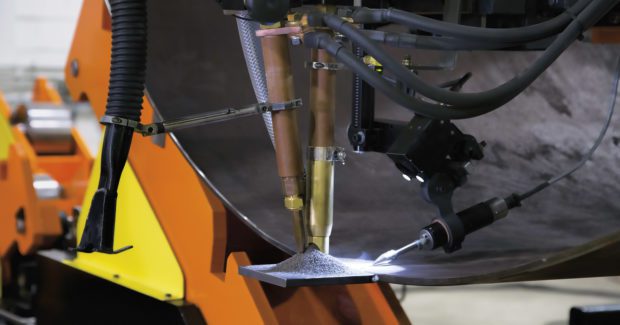How Submerged Arc Welding Can Improve Productivity
Ideal for demanding applications in pipe, pressure vessel and tank, railcar manufacturing and heavy construction/mining, this process offers great benefits in its simplest form of single wire welding, plus more in twin wire, tandem wire and multi-wire SAW configurations.
Posted: December 19, 2016
The submerged arc welding (SAW) process can offer significant benefits in many welding applications, from increased productivity to improved operator comfort and consistent high quality welds. Metal fabricators that are thinking of making a change to the SAW process should consider the numerous benefits it offers, as well as some key best practices to help them get the most from the investment.
SUBMERGED ARC BASICS
The SAW process is well-suited to demanding heavy industrial applications such as pipe, pressure vessel and tank, railcar manufacturing and heavy construction/mining. Applications that require high productivity rates or that involve very thick materials can especially benefit from the SAW process. The high deposition rates and travel speeds that can be achieved with this technology – and the significant impact these can have on an operation’s productivity, efficiency and bottom line – are among the key benefits of the process. Other benefits include the excellent chemical and mechanical properties of finished welds, minimal arc visibility and low fume that result in improved operator comfort, and good weld bead shapes and toes lines.
Submerged arc welding is a wire-fed process that uses a granular flux to shield the arc from the atmosphere. As the name suggests, the arc itself is buried in the flux, meaning the arc is not visible when parameters are correctly set with a sufficient layer of flux. The wire is fed through a torch that moves along the weld joint, and SAW can be used in single torch and multi-torch configurations. The arc heat melts a portion of wire, flux and base material to form a molten weld pool. The molten flux and metal freeze to form a slag-covered weld bead behind the arc. With the SAW process, welded metal thickness can range from 1/16 in to ¾ in thickness for a single pass with 100 percent joint penetration, and unlimited metal thickness on multi-pass welds, provided the proper joint preparation and wire/flux combination are employed.
FLUX AND WIRE SELECTION
Choosing the proper flux and wire for the specific SAW application is critical to achieving optimal results with the process. While the SAW process alone is a highly efficient one, productivity and efficiency can be enhanced even more based upon the wire and flux used. Flux is a crucial component that not only shields the weld puddle, but also contributes to mechanical properties and, ultimately, the productivity gains that are possible. The formulation of the flux is the great influencer on these factors, impacting the current-carrying capacity and slag release. Current-carrying capacity refers to the maximum current where the highest possible deposition rates and high-quality weld profiles can be obtained. The slag release of a specific flux impacts flux choice because some are better suited for certain joint designs than others.
Options in flux selection for SAW include active and neutral type fluxes. One basic difference: active fluxes change the chemistry of the weld, whereas neutral fluxes do not. Active fluxes contain silicon and manganese, in particular. These elements help maintain tensile strength at higher heat inputs, help welds wet out smoothly and provide good slag release at higher travel speeds. Overall, active slags can help reduce the risk of poor weld quality, as well as costly post-weld cleaning and rework. Keep in mind, however, that active fluxes are generally best suited for single or two-pass welding. Neutral fluxes are better for large multi-pass welds because they help avoid forming brittle, crack-sensitive weldments. When choosing a neutral flux, look for one with the lowest basicity index that still provides the necessary mechanical properties.
There are also many choices regarding SAW wire selection, each with strengths and weaknesses. Some wires are formulated for welding at higher heat inputs, while others are specifically designed with alloys that help the flux with weld cleaning. Be aware that the wire chemistry and heat input interact to impact the mechanical properties of the weld. Productivity can also be greatly enhanced by filler metal choice. Using a metal-cored wire with the SAW process, for example, can increase deposition rates by 15 percent to 30 percent compared to using solid wire, while also offering a wider, shallower penetration profile. Because of their high travel speeds, metal-cored wires can also reduce heat input to minimize weld distortion and the risk of burn-through. When in doubt, consult with a filler metal manufacturer to determine which wire and flux combinations are best suited for specific applications.
Understanding the American Welding Society (AWS; Miami, FL) classifications for SAW wires can also help when selecting the most appropriate option. Take the example of F7A8-EC1 per AWS code A5.17:
- The letter “F” at the beginning signifies it is a submerged arc welding flux.
- The “7” indicates the minimum tensile strength (in increments of 10,000 psi).
- The letter “A” designates the condition of heat treatment, with “A” for as-welded and “P” for post-weld heat treat.
- The number “8” indicates the temperature in Fahrenheit at which the impact strength of the weld metal meets or exceeds 20 ft-lb.
- The “EC1” indicates the chemical composition of the composite electrode.
PRODUCTIVITY GAINS
The SAW process offers great productivity benefits even in its simplest form of single wire welding. The process also offers numerous other options and torch configurations that can additionally benefit productivity, including twin wire, tandem wire and multi-wire SAW. While a switch to SAW may involve an upfront investment, it’s a process change that can pay off in significant productivity gains for many metal fabrication operations.
















